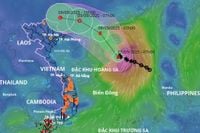In the early hours of September 7, 2025, meteorologists across Vietnam and southern China were on high alert as Typhoon No. 7—known internationally as Tapah—began to intensify rapidly over the northern reaches of the South China Sea. At 4 AM, the typhoon’s center hovered over the northern sea, packing sustained winds at category 8-9 (62-88 km/h) and gusts reaching up to category 11, according to reports from Vietnam’s national weather authorities and Vietnamnet.vn. The storm, initially almost stationary, lay about 350 kilometers east-northeast of the Hoang Sa (Paracel) archipelago and some 450 kilometers south of Hong Kong, China.
Forecasters warned that Tapah was primed for a dramatic surge in power. Over the course of September 7 and into the night, the typhoon was projected to strengthen by two categories as it moved northwest at a steady 10-15 kilometers per hour. The path was clear: by 4 AM on September 8, the storm’s center would be positioned over the southern sea area of Quang Dong (Guangdong) Province, China, with maximum intensity expected to reach category 10 and gusts up to a staggering category 13. "This may be the strongest intensity of the storm," noted Vietnam’s National Center for Hydro-Meteorological Forecasting, echoing the sense of urgency shared among regional disaster officials.
The threat extended well beyond wind speed. The northern South China Sea was forecast to experience winds at level 7-8, with areas near the typhoon’s center enduring category 9-10 winds and gusts up to level 13. Waves were expected to reach three to five meters, making the sea extremely dangerous for any vessels. Vietnamnet.vn emphasized, "Ships operating in the dangerous zones face strong winds, tornadoes, and high waves." The disaster risk level for this region was rated at level 3, signaling a significant hazard for maritime activity.
Despite the storm’s initial ferocity, land interaction was expected to sap its strength. On September 8, Tapah was forecast to make landfall in Quang Dong Province, China, where the friction with mountainous terrain would trigger a swift weakening. By 4 AM on September 9, the once-mighty typhoon would have diminished to a tropical depression over Quang Dong’s land area, with winds dropping to category 6-7 and gusts at category 9. The system would continue to lose steam, moving northwest at 15 kilometers per hour. By late afternoon, the depression would be centered over Quang Tay (Guangxi) Province, China, near the Vietnamese border provinces of Quang Ninh, Cao Bang, and Lang Son.
But the story doesn’t end with the weakening winds. The remnants of Tapah, now a tropical depression, were expected to unleash widespread heavy rain across northern Vietnam and parts of central Vietnam. According to the latest forecasts, these rains would begin in the afternoon of September 9 and persist through September 11. The deluge was set to be most intense in the mountainous and midland areas of Northeast Vietnam, as well as the Thanh Hoa region. Meanwhile, from Nghe An to Ha Tinh, scattered thunderstorms and periods of moderate to heavy rain were expected from the night of September 9 to September 11.
For many in northern Vietnam, the timing could hardly be worse. With the region’s rivers already swollen from earlier summer rains, the prospect of another round of torrential downpours raised fears of flash flooding and landslides—hazards that have repeatedly plagued the area in past years. Emergency management officials urged residents in vulnerable zones to stay alert and heed any evacuation orders. "Due to the influence of the tropical depression, northern Vietnam and the Thanh Hoa to Ha Tinh regions will experience a widespread heavy rain event," warned the national weather service. The focus, they stressed, would be on the mountainous and midland districts, where rainfall could be both sudden and intense.
Maritime authorities, meanwhile, scrambled to issue warnings to fishermen and shipping operators. The combination of high winds, towering waves, and risk of waterspouts created a treacherous environment for any vessel caught in the storm’s path. "All ships operating in the affected areas are at risk from strong winds, tornadoes, and large waves," reiterated Vietnamnet.vn, underscoring the immediate danger to life and property at sea.
This typhoon is just the latest in what has already been a notably active storm season for the South China Sea. Meteorologists have observed that 2025 is shaping up to be a year marked by both the frequency and unpredictability of tropical storms and typhoons. In fact, forecasts suggest that from now until the end of the year, the region could see between five and seven typhoons or tropical depressions forming over the South China Sea. Roughly half of these—three to four storms—are expected to have a direct impact on mainland Vietnam, a sobering statistic for communities still recovering from earlier weather events.
Tapah’s rapid intensification and unpredictable movement highlight the evolving challenges faced by weather forecasters in the region. As recently as the night before, the storm had remained almost stationary, leading some observers to hope it might fizzle out at sea. Instead, Tapah gathered strength with remarkable speed, underscoring the need for constant vigilance and up-to-date information. "In the past three hours, Typhoon No. 7 (Tapah) has hardly moved," reported the National Center for Hydro-Meteorological Forecasting at 7 AM on September 7. But within hours, the situation changed dramatically, with the storm accelerating and gaining power as it approached Chinese waters.
Looking ahead, the aftermath of Tapah will likely be measured not only in rainfall totals and wind damage, but in the resilience of the communities affected. With memories of previous seasons still fresh—when storms battered coastal and inland provinces alike—residents and officials are bracing for whatever the coming days may bring. The hope, as always, is that early warnings and careful preparation can help mitigate the worst effects of the storm.
As Tapah barrels toward the coast, it serves as a stark reminder of the region’s vulnerability to natural disasters. Yet, as history has shown, the people of northern Vietnam and southern China have weathered such storms before—and with vigilance, solidarity, and a bit of luck, they will do so again.




